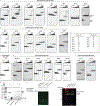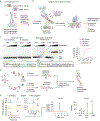Targeting MYC with modular synthetic transcriptional repressors derived from bHLH DNA-binding domains
- PMID: 36302987
- PMCID: PMC10392954
- DOI: 10.1038/s41587-022-01504-x
Targeting MYC with modular synthetic transcriptional repressors derived from bHLH DNA-binding domains
Abstract
Despite unequivocal roles in disease, transcription factors (TFs) remain largely untapped as pharmacologic targets due to the challenges in targeting protein-protein and protein-DNA interactions. Here we report a chemical strategy to generate modular synthetic transcriptional repressors (STRs) derived from the bHLH domain of MAX. Our synthetic approach yields chemically stabilized tertiary domain mimetics that cooperatively bind the MYC/MAX consensus E-box motif with nanomolar affinity, exhibit specificity that is equivalent to or beyond that of full-length TFs and directly compete with MYC/MAX protein for DNA binding. A lead STR directly inhibits MYC binding in cells, downregulates MYC-dependent expression programs at the proteome level and inhibits MYC-dependent cell proliferation. Co-crystallization and structure determination of a STR:E-box DNA complex confirms retention of DNA recognition in a near identical manner as full-length bHLH TFs. We additionally demonstrate structure-blind design of STRs derived from alternative bHLH-TFs, confirming that STRs can be used to develop highly specific mimetics of TFs targeting other gene regulatory elements.
© 2022. The Author(s), under exclusive licence to Springer Nature America, Inc.
Conflict of interest statement
Competing interests
T.E.S., X.S. and R.E.M. are named inventors on patent applications related to this work. The remaining authors declare no competing interests.
Figures














References
-
- Lambert SA et al. The human transcription factors. Cell 172, 650–665 (2018). - PubMed
-
- Talanian RV, McKnight CJ & Kim PS Sequence-specific DNA binding by a short peptide dimer. Science 249, 769–771 (1990). - PubMed
-
- Kouzarides T & Ziff E Leucine zippers of fos, jun and GCN4 dictate dimerization specificity and thereby control DNA binding. Nature 340, 568–571 (1989). - PubMed
-
- Blancafort P, Segal DJ & Barbas CF 3rd Designing transcription factor architectures for drug discovery. Mol. Pharmacol 66, 1361–1371 (2004). - PubMed
-
- Brent R & Ptashne M A eukaryotic transcriptional activator bearing the DNA specificity of a prokaryotic repressor. Cell 43, 729–736 (1985). - PubMed
Publication types
MeSH terms
Substances
Grants and funding
LinkOut - more resources
Full Text Sources
Other Literature Sources

